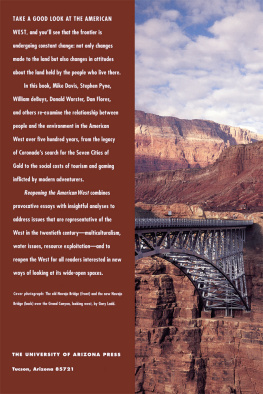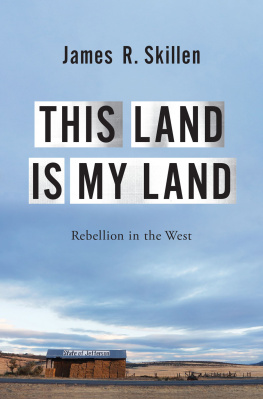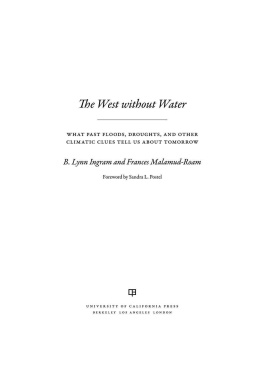Contributors
Mike Davis is a widely known and respected journalist and the author of City of Quartz:Excavating the Future in Los Angeles. Among his many projects is a coedited volumewith Hal Rothman entitled The Grit beneath the Glitter: Tales from the Real Las Vegas.He teaches urban theory at the Southern California Institute of Architecture in LosAngeles.
William deBuys is an author and professional conservationist who resides in SantaFe, New Mexico. He is the author of two highly acclaimed booksEnchantment and Exploitation:The Life and Hard Times of a New Mexico Mountain Range and, with photographer AlexHarris, River of Traps.
Dan L. Flores is Hammond Professor of History and Environmental Studies at the Universityof Montana in Missoula. He is the author of a series of influential and provocativearticles about environmental history and Caprock Canyonlands: Journeys into the Heartof the Southern Plains.
Robert Gottlieb is one of the leading scholars and writers about the American West.He is the author of numerous books about water, including A Life of Its Own: ThePolitics and Power of Water, as well as Forcing the Spring: The Transformation ofthe American Environmental Movement. He teaches at the University of CaliforniaLosAngeles.
Helen Ingram is the Warmington Endowed Chair and Professor at the University of CaliforniaIrvine,where she holds joint appointments with the School of Social Ecology and the Departmentof Politics and Society. Among her specialties is the relationship of water resourcesto political power and equity in the American West. Her first book, a study of the1967 Colorado River Basin Projects Act, was updated in a new edition: Water Politics,Continuity and Change. Her most recent coauthored book, Divided Waters, deals withU.S.-Mexico transboundary water resources.
Char Miller is a professor of history at Trinity University in San Antonio, Texas.His articles on the history of American forestry and the Forest Service frequentlyappear in scholarly and popular journals. Forthcoming works include American Forestry:Nature, Politics, and Culture, Out of the Woods: Essays in Environmental History,and a volume redefining the life of Gifford Pinchot.
Stephen J. Pyne is a professor of history at Arizona State University, Tempe, andthe author of numerous volumes on fire history throughout the world, including Firein America, World Fire, Vestal Fire, and Burning Bush: A History of Fire in Australia.
Hal K. Rothman is a professor of history at the University of NevadaLas Vegas, wherehe edits the journal Environmental History. His most recent books are The Greeningof Nation? Environmentalism in the United States since 1945 and Fll Never FightFire with My Bare Hands Again. His next book is Devils Bargains: Tourism and Transformationin the Twentieth-Century American West.
Marguerite S. Shaffer is an assistant professor of history at the University of NorthCarolinaWilmington. She has published in Pacific Historical Review and other journalsand has received grants from the Smithsonian Institution, Dumbarton Oaks, and theHuntington Library. Her article is derived from her first book, See America First:Tourism and National Identity, 1905-1930, which is forthcoming.
Donald Worster is the Hall Distinguished Professor of American History at the Universityof Kansas and one of the founders of modern environmental history. His works, includingDust Bowl: The Southern Plains in the 1930s and Rivers of Empire: Water, Aridity,and the Growth of the American West, have garnered countless awards as he definedand redefined various subfields. His most recent work is An Unsettled Country: ChangingLandscapes of the American West. He is a popular speaker and lecturer and one ofthe clearest voices of environmental history that reaches the public.

William deBuys
Dreams of Earth
Come over a little farther. Climb this gravel terrace and scan the open, naked desert.You must squint to see the few scrawny shrubs that stipple these badlands, and youcant escape the sense of being cut off and alone. Feel how hard the ground is underfoot.Hear how the gravel crunches like oyster shells. Mexicans call this kind of landpedregal: it is a pavement of cobbles and pebbles from which the wind has liftedevery grain of soil. Thus armored by subtraction, the barren ground has lain likethis a thousand years. Barring skid marks or spinning tires, it might so lie a thousandmore.
This is a sacred place. The broad circle etched in these gravels is the outline ofa shamans hut, long vanished from the site. And there, the curling path that doublesback on itself and comes twisting round again marks where the shamans people danced,year after year the same pattern, until their feet hammered a discernable trail intothe dark, sun-varnished ground. They also sang here. And they recited tales thattook a week of nights to tellweird, convoluted tales that never really ended andwould not fit our idea of what a story is, tales with passages that were little morethan recitations of the names of place after place: canyon, butte, hill, and plain,scattered over hundreds of desert miles. The tales obsession with geography exceedseven the obsession of the tribes of Israel with genealogy, which produced the tediousbegats of the Old Testament. Clearly the stories recited on this barranca helpedteach their listeners the tangled paths of the peoples mythology. It is temptingto believe they also helped teach paths of geography, so that among a people whoranged far and wide across the deserts, the right song or story might hold cluesenough to guide a person where he might never have beenall the way to the Hopi mesas,say, or westward to the sea.
They came also to this spot to dream, and they put great stock in dreams, as muchas any people ever have. They believed that all things worth knowing were to be learnedthrough dream and that little of importance might be learned in any other way. Themost powerful among them said they could dream their way back into the actual primordialenactment of the events of the mythic tales and songs they recited, back into thedecisive moments in the lives of their gods, back even to the earliest moments ofcreation. At such a place as this gravel terrace, dreamers sought those dreams or,sleeping elsewhere, traveled here in dream, or thought they did, for purposes beyondthe limits of our ken.
If ever you would contemplate the dreams of those who wished not to reclaim the earth,only to inhabit it, absorb this place in your mind. You may be sure they did. Lookthere: the outline of a lizard, ten yards long, lies embedded in the pedregal. Theyshaped the body by removing the desert gravel to bare the clay beneath, and theybermed the lifted gravel around the edges of the figure to emphasize its outline.The lizards legs they made a different way, beating the gravels deeper in the clay,much like the path of the dance pattern.
And over here. Come on, though its a fair walk. Now see what they scraped and tampedin the gravels. The bison on the walls of Lascaux are not more beautiful than thissnorting, coiled-neck horse with flowing mane and a luxuriant fountain of a tail.This beast might haunt the dreams of anyone, including us. It is the soul of thisplace and the heart of our story, which is the story of the greatest encounter inthe history of these landsor of any lands on the continent. This story, repeatedwith variation everywhere in North, Central, and South America, is the bizarre andonly half-articulated story of first encounters between the native people of thishemisphere and the emissaries of Europe.






